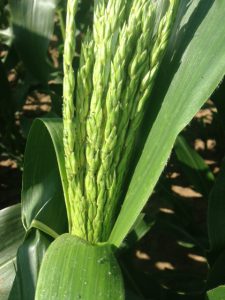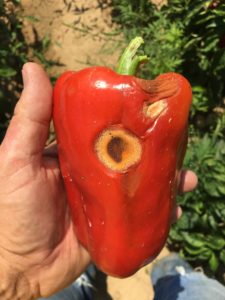Sweet Corn
European corn borer (ECB) moth catches are extremely low. The second flight has been very weak. Feeding signs in whorl corn remain low. There will be no map in this edition. Second generation feeding is often obscured by fall armyworm (FAW) feeding. Once plants hit full tassel, any ECB larvae present will move downward on the stalk and re-enter the plant near the area where ears are forming. This can result in direct injury to the ear. Growers should consider an insecticide application at the full tassel stage to target ECB larvae as they migrate downward. This application can eliminate larvae that have escaped any earlier insecticide applications.
The highest nightly trap catches of ECB for the week ending 8/29/18 are as follows:
| Asbury 1 |
| Downer 1 |
| Eldora 1 |
| Folsom 1 |
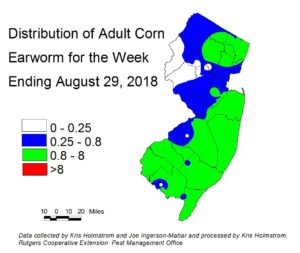 The corn earworm (CEW) situation has remained fairly stable over the past week. CEW numbers are getting a bit more consistent in traps, although we continue to have some black lights registering no catch. This may be due to unfavorable site location
The corn earworm (CEW) situation has remained fairly stable over the past week. CEW numbers are getting a bit more consistent in traps, although we continue to have some black lights registering no catch. This may be due to unfavorable site location 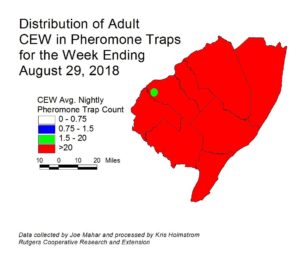 or lack of proximity to host crops. The CEW pheromone trap network in the southern counties continues to capture large numbers of moths in several locations (see CEW blacklight map at left, and pheromone trap map at right). There are many fewer pheromone traps than blacklight traps. This results in much broader colored patches on the pheromone maps. The blue area on the blacklight map indicates an approximate 4-5 day silk spray schedule, while green would be 3 days. On the pheromone map, the red area indicates a solid 3 day schedule depending on location. Trap catches from North Carolina and Virginia are variable, but some traps in both states are recording high numbers. In general, NJ catches are higher than those in Delaware at this time. The current pattern of winds from the south/southwest will continue to allow good CEW movement into our area. As fontal systems approach from the west, the inflow of CEW often increases until the front passes. Late August into September is traditionally when second generation CEW moths arrive in high numbers.
or lack of proximity to host crops. The CEW pheromone trap network in the southern counties continues to capture large numbers of moths in several locations (see CEW blacklight map at left, and pheromone trap map at right). There are many fewer pheromone traps than blacklight traps. This results in much broader colored patches on the pheromone maps. The blue area on the blacklight map indicates an approximate 4-5 day silk spray schedule, while green would be 3 days. On the pheromone map, the red area indicates a solid 3 day schedule depending on location. Trap catches from North Carolina and Virginia are variable, but some traps in both states are recording high numbers. In general, NJ catches are higher than those in Delaware at this time. The current pattern of winds from the south/southwest will continue to allow good CEW movement into our area. As fontal systems approach from the west, the inflow of CEW often increases until the front passes. Late August into September is traditionally when second generation CEW moths arrive in high numbers.
Please note: It bears repeating!! A number of growers have experienced unsatisfactory control of CEW when using synthetic pyrethroid insecticides (IRAC class 3A) in the silk spray program. CEW resistance to this class of insecticides is well documented and has increased in recent years. Growers should rotate among IRAC class 28 materials (Coragen, Besiege (28+3A)), class 5 (Radiant, Entrust, Blackhawk), and class 1A (Lannate) for acceptable control. Growers of Attribute I and Performance Series sweet corn (expressing B.t. traits) should consider adhering to silk spray schedules prescribed for non B.t. sweet corn. At this time, Attribute II varieties are not known to support CEW larvae.
The highest nightly black light trap catches of CEW for the week ending 8/29/18 are as follows:
| Denville 4 | East Vineland 2 | Woodstown 2 |
| New Egypt 4 | Green Creek 2 | Farmingdale 1 |
| Centerton 2 | Milltown 2 | Jobstown 1 |
| Downer 2 | Tabernacle 2 | Sergeantsville 1 |
The highest nightly pheromone trap catches of CEW for the week ending 8/29/18 are as follows:
| Monroeville 95 | East Vineland 33 |
| Pedricktown 90 | Woodstown 21 |
| Berlin 64 | Snyder Farm (Hunterdon Co.) 15 |
| Green Creek 62 | Belvidere (Warren Co.) 8 |
| Elm 35 | Beckett 4 |
Silking Spray Schedules*:
South – 3 days
Central – 3 days
North – 4 days
*These recommendations are based on regional catches. Adhere to tighter spray schedules if indicated by local trap catches.
Fall Armyworm
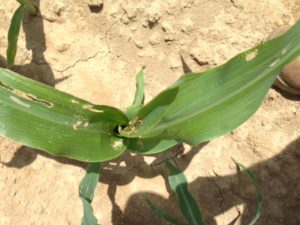 Fall armyworm (FAW) infestations remain light, although single digit infestations are becoming more common. Pheromone trap catches are unusually low. Continue scouting regularly for this pest. Look for significant injury in whorls, with all damage leading directly into the center of the plant (see photo at left). FAW larvae consume lots of tissue, and grow rapidly . Be sure to check seedling stage plantings as well, as FAW will attach even small plants. Consider treating if plants infested with FAW alone, or in combination with ECB exceed 12%. FAW is resistant to synthetic pyrethroid insecticides. Effective materials include those in IRAC groups 5 (Radiant, Entrust (OMRI approved)), and 28 (Coragen, Exirel).
Fall armyworm (FAW) infestations remain light, although single digit infestations are becoming more common. Pheromone trap catches are unusually low. Continue scouting regularly for this pest. Look for significant injury in whorls, with all damage leading directly into the center of the plant (see photo at left). FAW larvae consume lots of tissue, and grow rapidly . Be sure to check seedling stage plantings as well, as FAW will attach even small plants. Consider treating if plants infested with FAW alone, or in combination with ECB exceed 12%. FAW is resistant to synthetic pyrethroid insecticides. Effective materials include those in IRAC groups 5 (Radiant, Entrust (OMRI approved)), and 28 (Coragen, Exirel).
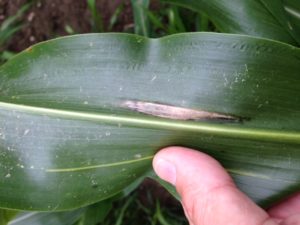 Continuous wet weather has created a perfect environment for the development of northern corn leaf blight (NCLB). This foliar disease of corn causes elongated, gray lesions on the leaves (see photo at left). NCLB attacks older tissue first, but can move further up the plant when wet conditions permit spore production and germination. Ultimately, NCLB can cause unsightly lesions on ear husks and even poor ear size if is uncontrolled. If NCLB is detected in sweet corn prior to silking, one or more fungicide applications may be warranted. See the Sweet Corn section of the 2018 Commercial Vegetable Recommendations for useful fungicides.
Continuous wet weather has created a perfect environment for the development of northern corn leaf blight (NCLB). This foliar disease of corn causes elongated, gray lesions on the leaves (see photo at left). NCLB attacks older tissue first, but can move further up the plant when wet conditions permit spore production and germination. Ultimately, NCLB can cause unsightly lesions on ear husks and even poor ear size if is uncontrolled. If NCLB is detected in sweet corn prior to silking, one or more fungicide applications may be warranted. See the Sweet Corn section of the 2018 Commercial Vegetable Recommendations for useful fungicides.
Corn leaf aphid (photo at right) is a fairly common insect pest of late stage sweet corn at this time, particularly if pyrethroid insecticides have been used. To help manage this insect, and prevent it from becoming a possible contaminant at harvest, consider including Lannate early in the silk spray schedule. Additionally, the neonocotinoid Assail is labeled for aphid control on sweet corn and is much less toxic to bees than other neonicitonoids. Assail has no caterpillar activity, so it must be in addition to the worm material that is used.
Several farms in the northern counties have developed anthracnose fruit rot infections in pepper fields. This disease can spread rapidly under wet conditions. Anthracnose causes a depression on the side of fruit, with pinkish curd-like spores (see photo at left). Ideally, infected fruit should be removed from the field, even if this means separate buckets for picking crews. This will help limit inoculum in the field. Additionally, anthracnose requires specific fungicides to limit spread. These may be found in the Pepper section of the 2018 Commercial Vegetable Recommendations.
Pepper Weevil
As far as is known, there are no other infested fields outside of the Hammonton area. The population in one field has been contained and hasn’t spread across the field as in past infestations.
Beet Armyworm (BAW)
Pheromone trap catches of BAW in southern NJ are low in general, with the only notable catch still in the Woodstown area of Salem County. No crop injury has been detected.
Tomatoes
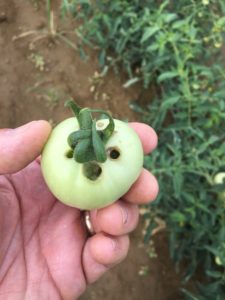 There remain localized fruit worm (CEW)
There remain localized fruit worm (CEW) 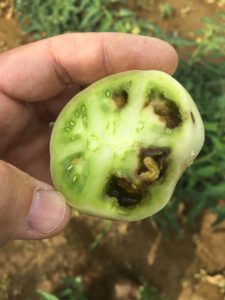 infestations in tomatoes. This has primarily been observed in coastal counties, but may be happening elsewhere; especially in coastal areas. CEW moths lay eggs near flower clusters in the upper portion of the plant. Larvae bore into developing fruit (see photo at left). If CEW moths are being caught locally in traps, and this type of injury or live worms (see photo at right) show up in more than one site in a 10 site sample, growers should consider treating. Insecticides in the IRAC 28 group (Coragen) or 5 (Entrust, Radiant) have very short harvest intervals and are effective at controlling these larvae.
infestations in tomatoes. This has primarily been observed in coastal counties, but may be happening elsewhere; especially in coastal areas. CEW moths lay eggs near flower clusters in the upper portion of the plant. Larvae bore into developing fruit (see photo at left). If CEW moths are being caught locally in traps, and this type of injury or live worms (see photo at right) show up in more than one site in a 10 site sample, growers should consider treating. Insecticides in the IRAC 28 group (Coragen) or 5 (Entrust, Radiant) have very short harvest intervals and are effective at controlling these larvae.
Stink bugs and cabbage looper (CL) caterpillars are also fairly common in tomato plantings at this time. The latter does little real damage to plants; feeding mainly on foliage. However, stink bugs can cause extensive fruit blemishes, and nymphs of our native brown species are now occurring in scouted fields. Stink bugs are most easily detected by taking a slow walk down tomato rows. Look ahead as you walk, paying particular attention to sunny spots where bugs often bask in the morning. Consider treating if these bugs are found in more than one location in the field.
Brown marmorated stink bug (BMSB)
 BMSB catches in black light traps continue to drop. At the present time, the heaviest catches are in Hunterdon and Mercer counties, although even these are fairy low. Although this pest has not had serious impact on vegetable crops like peppers in recent years, it is still a significant pest of tree fruits.
BMSB catches in black light traps continue to drop. At the present time, the heaviest catches are in Hunterdon and Mercer counties, although even these are fairy low. Although this pest has not had serious impact on vegetable crops like peppers in recent years, it is still a significant pest of tree fruits.
The highest nightly trap catches of BMSB for the week ending 8/29/18 are as follows:
| Allentown 2 | Asbury 1 | Green Creek 1 |
| Clinton 2 | Belvidere 1 | Matawan 1 |
| Little York 2 | Denville 1 | Old Bridge 1 |
| Princeton 2 | East Vineland 1 | Woodstown 1 |
Pumpkins and Winter Squash
 All growers should be applying appropriate downy mildew (DM) fungicides on all cucurbit plantings now. CDM has been found on pumpkins and other cucurbit crops throughout the state. CDM causes yellow “panels” to develop on the upper leaf surface (see photo at left) with dark sporulation forming on the lower leaf surface (see photo at right). CDM can defoliate
All growers should be applying appropriate downy mildew (DM) fungicides on all cucurbit plantings now. CDM has been found on pumpkins and other cucurbit crops throughout the state. CDM causes yellow “panels” to develop on the upper leaf surface (see photo at left) with dark sporulation forming on the lower leaf surface (see photo at right). CDM can defoliate  fields in a matter of several days during wet conditions such as we are currently enduring. Our present weather pattern has New Jersey cucurbit crops under constant threat of CDM infection from spore sources locally and from more southern sources. For detailed CDM forecasts, see the following website: http://cdm.ipmpipe.org/ All growers are encouraged to check this website at least once a week. NJ is considered to have little risk of infection from outside areas through mid week, but heavy dews now occurring will increase in-field spread in currently infected fields. IPM scouts frequently detect DM lesions on leaves, but when appropriate fungicides are being used, these lesions are not actively producing spores. For a list of DM specific fungicides, see the Pumpkin and Winter Squash section in the 2018 Commercial Vegetable Recommendations.
fields in a matter of several days during wet conditions such as we are currently enduring. Our present weather pattern has New Jersey cucurbit crops under constant threat of CDM infection from spore sources locally and from more southern sources. For detailed CDM forecasts, see the following website: http://cdm.ipmpipe.org/ All growers are encouraged to check this website at least once a week. NJ is considered to have little risk of infection from outside areas through mid week, but heavy dews now occurring will increase in-field spread in currently infected fields. IPM scouts frequently detect DM lesions on leaves, but when appropriate fungicides are being used, these lesions are not actively producing spores. For a list of DM specific fungicides, see the Pumpkin and Winter Squash section in the 2018 Commercial Vegetable Recommendations.
